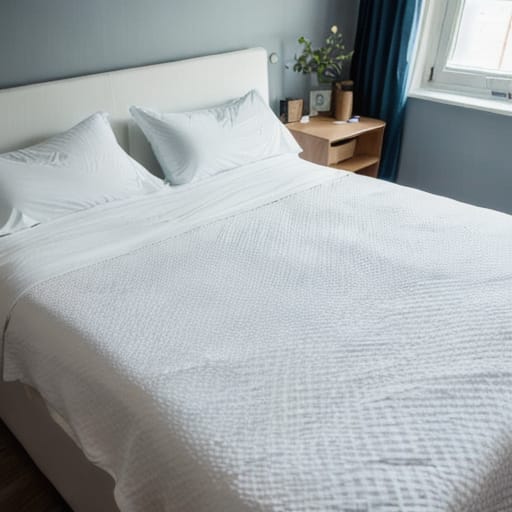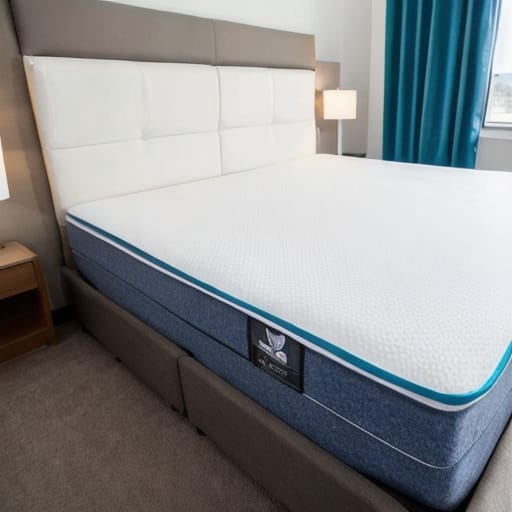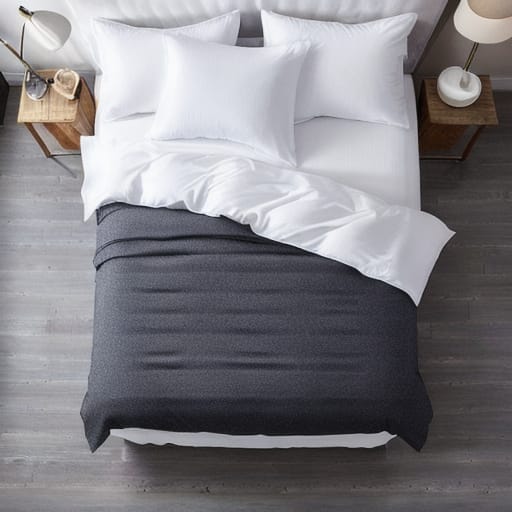When it comes to bedding, down comforters stand out for their unbeatable softness and lightweight warmth. But some wonder – are down comforters hot for sleeping?
The short answer is: it depends. The warmth of a down comforter correlates closely with the fill power and materials used. With the right style, even notoriously warm sleepers can enjoy these luxuriously soft covers without overheating.
In this beginner’s guide, we’ll explore the ideal temperature regulation of down comforters to help you find your perfect match.
A Primer on Down Comforters
Before deciding if down is too hot for your needs, it helps to understand what defines these plush blankets in the first place.
Down comforters consist of a lightweight duvet filled with insulation. This insulation comes from duck or goose down clusters, the fluffy undercoating found beneath feathers. These soft, airy plumes create unbeatable warmth without adding extra weight.
Unlike heavier covers like wool blankets or quilts, down comforters provide top-notch temperature regulation. The fill’s impressive warmth-to-weight ratio allows it to trap body heat without causing sweatiness or heat buildup.
For this reason, down comforters offer exceptional breathability for most sleepers, minus those who run exceptionally warm. Proper airflow prevents you from getting that stifled, uncomfortable feeling through the night.
Factors That Impact Down Comforter Warmth
Are you wondering if that hotel-worthy down comforter will keep you nice and toasty or unpleasantly hot? Consider the following factors:
Fill Power
Fill power refers to the fluffiness and loft (volume) that the down fill provides. It ranges from about 400 up to 900. The higher the number, the better the insulation with less actual down required.
Fill power depends largely on the type of bird. Goose down offers higher fill power than duck down, as the clusters are larger. Fill power exceeds 600 in quality goose-down comforters.
Higher fill power options work well for colder environments or cooler sleepers. For hot sleepers, fill power between 400-600 balances coziness with breathability.
Shell Materials
Down comforters come wrapped in a shell that encases the fill. Most feature a cotton shell, which offers good airflow.
Some modern options also incorporate cooling technologies like temperature-regulating Outlast®. This advanced lining fabric absorbs and releases heat as needed, preventing overheating.
For improved cooling, look for comforters with breathable cotton, lightweight shell materials, or specialized temperature-regulating technology.
Seasonality
Winter comforters pack more fill for extra coziness during colder months. These trap heat effectively, which can cause sweating in warmer weather.
All-season or summer-weight options better maintain that “cool enough” balance. These lightweight styles allow good airflow for temperature regulation year-round.
Construction Style
Beyond materials, the style of construction also impacts airflow and heat retention levels.
- Baffle box design: Small fabric boxes stitched throughout the comforter keep the fill evenly distributed. This allows body heat to dissipate instead of building up.
- Sewn channels: Lengthwise fabric tunnels hold the fill in place. More breathable than traditional quilted comforters, these maintain airflow.
Prioritize baffle box or sewn channel construction for the most cooling effect in a down comforter.

Finding the Right Warmth and Cooling Power
Down comforters span the spectrum from ultra-warm, plush, and cozy to lightweight and breathable. Which you choose comes down to your temperature preferences and needs:
For Hot Sleepers
Self-described “furnaces” in bed will want to avoid overheating. Seek out the following specific features:
- Low fill power, around 400-550
- Light, breathable shell fabric
- Cooling technologies like temperature-regulating linings
- Lightweight summer styles
- All-season designs suitable for warm weather
With a quality-made, well-ventilated cover optimized for airflow, even hot sleepers can enjoy down’s vaunted softness.
For Cold Sleepers
Do you sleep “cold”? Then that fluffy down is calling your name.
Ideal features for cold sleepers include:
- Higher fill power, 600+
- Heavier weight options
- Winter or extra warmth styles
- Closer-fitting shell to trap body heat
With the right fill density and construction, down comforters provide that sought-after “resort bed” feeling of enveloping plushness without making you overheat.
Assessing Down Comforter Quality
Not all down comforters live up to their luxury hype. Be sure to assess for the following marks of quality:
- 650+ fill power – Anything less won’t provide adequate loft and insulation
- 75% down minimum – Quality down with less feather quill by volume
- Tightly woven, 300-thread count shell – Ensures fill stays evenly distributed inside
- Baffle box design – Prevents cold spots by keeping insulation uniform
- Certifications like DownPass confirm ethical sourcing
With the right credentials, your down comforter should provide many years of welcoming warmth.
Caring for a Down Comforter
To enjoy your down comforter for years, proper care is key. Follow these best practices:
- Spot clean stains gently instead of washing them frequently
- Dry clean for deeper cleaning every 2-3 years
- AIR DRY thoroughly after any washing – tumble drying can damage feathers
- Store folded or hanging to prevent compression damage between uses
By caring for your comforter properly, you’ll enjoy durable coziness and sweet dreams for years of restful nights!

Achieving the Perfect Balance of Luxury & Comfort
For unbeatable softness paired with breathability, down comforters can’t be matched. Just be sure to select the right fill power, shell materials, and construction to find your perfect equilibrium of blissful snugness and just-cool-enough comfort.
With light yet insulating fills, advanced cooling fabrics, and proper handling, even notoriously “hot” sleepers can enjoy hotel luxury from the comfort of home.
Frequently Asked Questions
Are down comforters hotter than other comforters?
Not necessarily. Thanks to the impressive warmth-to-weight ratio of down, these comforters tend to provide better breathability than heavier covers like wool or cotton. The key is choosing one with an appropriate fill power and construction for your needs.
What is the warmest down comforter fill power?
For maximum warmth, opt for fill power of 700 or higher. This higher loft traps more body heat without adding extra weight. Fill power around 600 plus offers a nice balance of warmth without getting overly hot for most people.
What thread count is best for down comforters?
Look for a tightly-woven, 300 thread count shell or higher. This helps encase feathers securely so they don’t escape through the fabric. It also contributes to even warmth distribution across the comforter.
Can you put a down comforter in the washing machine?
It’s not recommended. The agitation of a washing machine, even on delicate, can damage the baffle boxes that protect the down fill. Instead, opt for spot cleaning stains and professional dry cleaning every 2-3 years to clean comforters thoroughly.
How do I make my down comforter cooler?
Those who tend to sleep hot can improve cooling power with the following:
- Seek out temperature regulating fabrics like Outlast® lining
- Choose lower fill power around 400-550
- Select ultra lightweight, summer-specific styles
- Prioritize baffle box construction over quilted
What is the most luxurious fill power for down comforters?
For ultimate luxury and cozy warmth, you can’t beat fill power over 700 – the highest grade available. This exceptionally fluffy, lofty down provides enveloping softness perfect for cold winter nights.
Are down comforters worth the money?
Down comforters may cost more upfront but last for years or decades when properly cared for. Their matchless lightweight warmth makes them a worthy investment for many. Just be sure yours meets quality benchmarks like 650+ fill power and DownPass certification. With the right credentials, down delivers on luxury.








